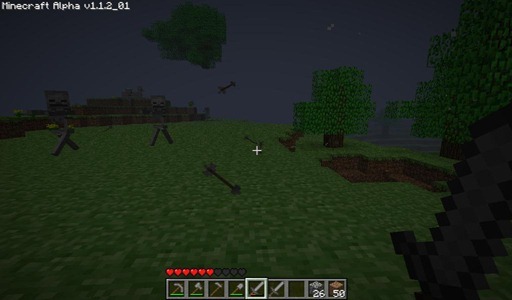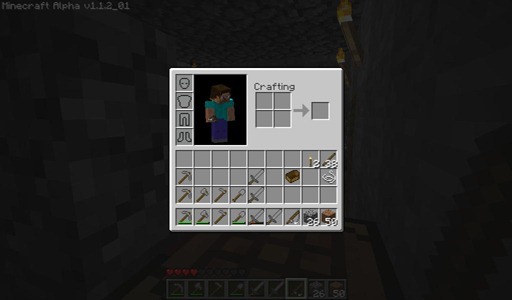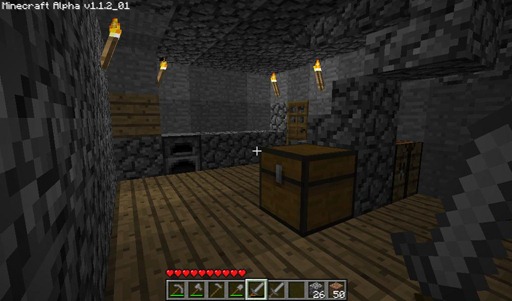I’ve been playing rather a lot of Minecraft lately, and I’m not alone. For those few of you who don’t know, this is a game which has taken the intertubes by storm, a cuboid sandbox nirvana where you can build, explore dungeons, create whole cities, and much more. You begin on a procedurally generated random world, population: 1. It’s like LOST meets LEGO where everything is built from cubes. The style you’ll either love or hate, but the cubist design quickly fades into the background as you become involved in your virtual world. Beginning with nothing more than the square clothes on his back, your latter-day Robinson Crusoe has to build his own tools, find shelter and build a new life for himself. All before nightfall.
The question for today is: What can Minecraft teach we role-players?
Quite a lot, actually.
1. Sometimes, Alpha is good enough
Minecraft is currently billed as Alpha level software, though it is rapidly approaching Beta. Despite this it is remarkably stable, but some things don’t work as they should (or at all), and each update to the game brings with it new items, innovations and tweaks – some of which have been known to break the game entirely. For example, you can build a fishing rod, but there’s currently no fish in the game! Tantalizing peeks into the future of the game keep the excitement level high, as every update improves on the already solid core. Notch, the incredibly talented coder behind it all, sometimes releases Secret Friday patches that add new features to the game, but no clues as to what they are. You have to discover them for yourself! It’s like a fresh Easter Egg, every time.
I have a fishing rod and a boat. And lots of patience.
Why would you want to play with something that’s not even ready to be called Beta quality? The answer is that Minecraft is easily good enough, right now. As it stands, players have made the USS Enterprise, countless entire cities (just one of many) and dungeons (again, of many), and even a feature-complete microprocessor, all inside the existing Minecraft engine. Head over to YouTube to find no end of astounding Minecraft creations ranging from complete machinery to works of art and massive jaw dropping acts of destruction. It’s all there.
When it comes to rpg campaign world design, it’s much the same. Alpha is good enough. You don’t need a fully fleshed out world in place before you run your first adventure. Heck, you don’t even need a map of the nearest village. Just like Minecraft, your fledgling campaign world can begin with nothing more than a vague idea and a few sets of blocks. Build and evolve the world as your game progresses. Add new tweaks to maintain the players interest – perhaps one session they crest a hill to discover an entire coastline, a sailing ship waiting by a wooden dock. End the session there, and they’ll be itching to know what happens next.
You can drop in Secret Friday style patches too, little changes to the existing game world that keep things fresh and alive in the player’s mind. Have their local Armoury be taken over by a pack of civilised Ghoul Merchants, or a nearby bridge be washed away due to flooding (doubtless resulting in a homeless and very upset Bridge Troll roaming the countryside). Note down these little snippets as you think of them, but the players only encounter them when they go there. Events such as this make excellent fodder for Minor Quests too. Perhaps your Cleric wants to ensure that the Ghouls intentions are honourable, while the Dwarf swears to have the Troll’s bridge rebuilt. Easy, colourful XP fodder means everyone is a happy gamer.
2. Multiple game modes
Minecraft can be played in a variety of modes, with more planned as development continues. The Classic “Creative” mode is free and playable right in your browser (requires Java), while buying Minecraft lets you download the full game which includes the single player Survival Mode and Multiplayer Mode. More modes are planned, including a full Adventure Mode (procedural Dungeons ftw!), an Economic Mode, and much more. It has also been discussed that later these modes could be mixed and merged to create your own customized gaming experience. For example, if you prefer a game involving exploring Dungeons and trading goods in a multi-player setting, that’s just a set of switches away.
Minecraft lets you play the game however you want. If you prefer to build, you can build. If you want to slay monsters, they are waiting to be slain. If you want to recreate an entire Mario level in 3D, dive down waterfalls, manage a farm and ride a pig, it’s all there. It’s a full sandbox environment where the primary limitation is yourself.
 Why yes, this screenshot was very dangerous to get. Thanks for asking.
Why yes, this screenshot was very dangerous to get. Thanks for asking.
A good role-playing session should be the same. Role-playing doesn’t have to be about going from one combat to another fighting monsters for three hours. If you want it to be, that’s cool. We all need those sessions to let off steam sometimes. But nothing – NOT IN 4E D&D AND NOT IN ANY OTHER RPG, EVER – says this is how you must play the game. Some of our best role-playing sessions contained no combat whatsoever, while others were spent collectively designing a castle and managing our heroes’ domain. We have led entire armies into battle using the D&D Rules Cyclopedia, and in Traveller mapped whole sub-sectors of space and poured over trade charts to work out the best use of our ship’s cargo hold.
Each genre brings its own sandbox full of tropes to the table, but the only true limitation is yourself. There’s nothing in D&D to stop you playing a Cartographer whose only interest is in mapping the Dungeon (and hiding behind the Fighter when things get nasty!), or a Merchant who is eager to trade with the savage natives of the Underdark. Perhaps your Cleric wants to bring the Light of Pelor into the shadowy spaces, or your Rogue be on the run from an invisible stalker that is always 5 squares behind him.
How you play is up to you. What’s your game mode?
3. Time passes
In Survival Mode, it’s essential to keep an eye on the passage of the sun as when it dips below the horizon the monsters come out to play. While the daylight hours are relatively monster free (aside from docile Giant Spiders and dark places underground), night-time is populated by zombies, bow-wielding skeletons, exploding creepers and those Giant Spiders aren’t so docile any more. The general idea is to gather your supplies during the daylight hours then head back to safety behind walls (or a nice warm cave) to build your equipment at night. If you are inclined toward adventuring (which I suspect may well be the case), craft a sword and set of armour, and you can go monster hunting by moonlight!
Over in the world of D&D, picture the scene: villagers toil in the fields, frantically gathering the harvest as the sun sets, the look of fear well worn on their sweating brows. As the last light fades the ground stirs as Zombies rise, and from the forests Goblins form from the very shadows of the trees themselves. This is Ravenloftian (which isn’t a word, but should be) Points of Light writ large, where the surrounding Darkness overtakes the world come nightfall. Superstitious peasants cross themselves and shutter their windows, praying to the gods that dawn comes quickly.
I’m in here and the monsters are out there. It’s like Dungeon, in reverse!
In a world like this, Extended Rests are something found only behind stout barricades or in well-lit areas. Every village has at least a wooden palisade, and no journey is attempted that takes more than eight hours to make. Your hero’s most important possession is his horse – at least until bandits attack and the horse is slain. The heroes have many hours ahead of them by foot until they reach the next town. Good luck with that.
Use the passage of time in your game to keep the pressure on and the action flowing. If they have to rescue the princess before the first light of dawn strikes the Eye of the Killing Stone, or need to locate the Night Hag and haggle for a potion to cure the King of Lycanthropy before the next full moon, your players will press on whereas otherwise they would stop to rest and recover. Make it clear to them that time, more than anything else, is their biggest enemy in this adventure. That’s not something they can defeat with sword thrusts and blasty magic!
That’s quite enough for one post. Coming up: Part Two!
If you want to try Minecraft yourself, head over to http://minecraft.net/ and try Minecraft Classic for free, or buy the full Alpha release with Single Player Survival and Multiplayer Modes for just 10 Euros (about £8.50, or $13) and get all the updates for free, forever. You know you want to.






You should play Fallout. It’s the exact same scenario.
Turns out that someone is making a 1:1 scale of the U.S.S. Enterprise! http://www.youtube.com/watch?v=kn2-d5a3r94
You are surely trying to sneak a lot of 4E apologetics into your post. The system is bad, deal with it already.
4e D&D is excellent. It’s people who say it is bad who are bad. Deal with it.
Have fun playing your boardgame.
:snort: